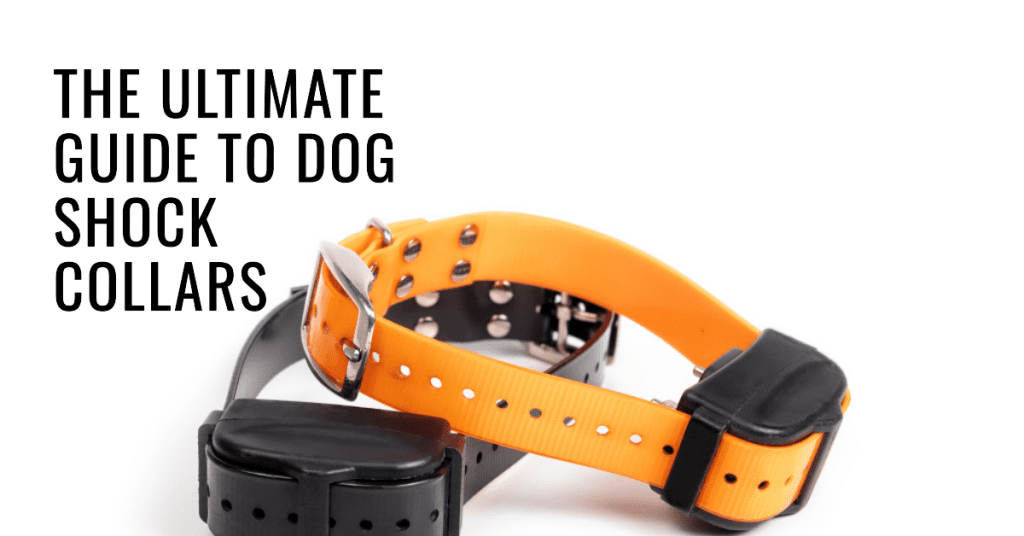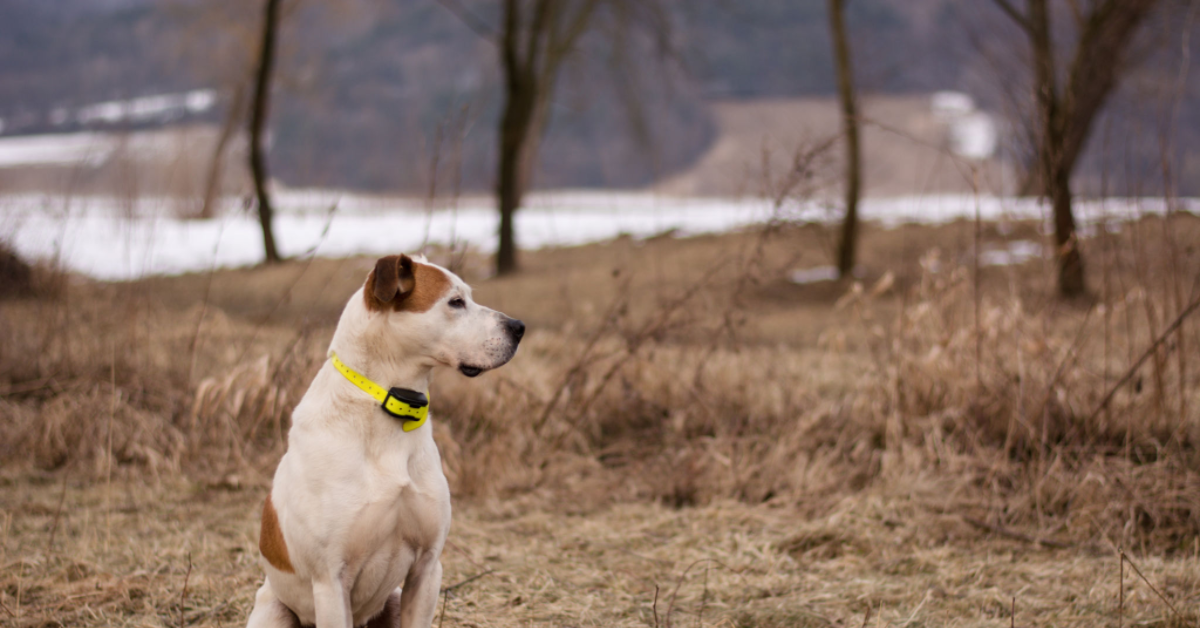Dog shock collars can be a great way to get your dog to comply when you ask it to do something
How do dog shock collars work? Why are they effective? Which is the best training collar for my dog? This guide will help answer these questions and much more. You’ll learn everything about shock collars so that you can take the right decision.
So, let's dive into Ultimate Guide to Dog Shock Collars…..
As an Amazon Associate, we earn from qualifying purchases
What is a Dog Shock Collar?


A dog shock collar is a training device that uses an electrical pulse to deter unwanted dog behavior. Dog shock collars are the most popular training tools for dogs as they can be used in any situation and anywhere. They are also very effective as they can be used on dogs of all ages and sizes.
How do Shock Collars Work?
A shock collar emits an electric current to a dog's neck when it is triggered by a remote control or an automatic device. The current is very mild, usually a slight tickling sensation. The idea behind this exercise is to provide stimulus to the dog in order to discourage and suppress unwanted behavior, such as barking, jumping, or chasing.
It works by emitting an electric current through two metal prongs that touch the dog's skin. They are typically adjustable to fit different sizes and breeds. When the dog exhibits undesirable behavior, the owner or trainer activates the training collar, and the dog feels the electric shock. Some dog training collars also emit a warning sound or vibration before the shock, to give the dog a chance to respond to the command without being shocked.
Shock collars are effective tools that can help us train our dogs in a positive manner. However, there are certain precautions we need to take when using a shock collar, including understanding its effectiveness, safety, and proper application.
Types of Shock Collars
There are many shock collars in a variety of styles and designs, each with its own unique features and capabilities.
| Feature | Static Shock Collar | Ultrasonic Collar | Vibration Collar |
|---|---|---|---|
| Training Method | Uses static shock | Emits ultrasonic sound waves | Provides vibration |
| Sensation | Uncomfortable | High-pitched noise | Gentle vibration |
| Intensity Levels | Adjustable | Usually not adjustable | Adjustable |
| Training Effectiveness | Immediate response | Varied effectiveness | Varied effectiveness |
| Safety Concerns | Potential for harm | Generally safe | Generally safe |
| Human Involvement | Requires remote control | Automatic or manual activation | Automatic or manual activation |
| Range | Limited range | Limited range | Limited range |
| Suitability | Dogs with strong-willed or aggressive behavior | Dogs with sensitive hearing or noise aversion | Dogs sensitive to touch or vibration |
| Training Approach | Aversive training | Behavioral modification | Behavioral modification |
| Acceptance | Controversial | Mixed opinions | Generally accepted |
Static shock collar
Static Dog Collar or e-collar works by sending out small electrical pulses which are uncomfortable enough to keep your dog from barking or engaging in unwanted behavior. It does not harm your dog, but it's designed to be uncomfortable enough to deter bad behavior.
Ultrasonic collar
An ultrasonic bark collar is a great way to train your dog. They're an effective, non-electric solution, and don't shock your dog's sensitive skin but use high-pitched sounds to suppress the unwanted behavior. They make great training tools for people who don't want to use electric stimulation.
Vibration collars
These collars are similar in design to e-collars but use beep or vibration instead of electric stimulation. Vibration collars are ideal for dogs with sensitive skin or those who are easily startled by electric stimulation. They're also a great option for owners who want a more humane way of dog training and want to avoid the use of shock collars.
Pros and Cons of Shock Collars
Let's examine the pros and cons of using them.
Pros
- Effective for training dogs with behavioral issues
- Deters unwanted behaviors like excessive barking, digging, and jumping up
- Adjustable settings for tailored shock levels
- Allows customization based on the dog's temperament
Cons
- Perceived as cruel and inhumane by some
- Potential to cause unnecessary pain and discomfort to dogs
- Improper use can worsen behavioral issues
- May lead to additional problems if not used correctly


Training Tips for Dog Shock Collars
If you're considering using a shock collar or e-collar for dog training, there are several tips that can help make the process smoother.
Establish a Clear Command
Training a dog to respond to a shock collar is relatively simple if you use the clear command so that your dog can follow. Clear commands are an integral part of effective communication with the dog. To establish a clear command:-
Establish a Clear Command
- Choose a specific word or phrase for each command (e.g., “sit” or “come”).
- Use a firm and assertive tone when giving the command.
- Maintain consistency in your tone of voice for each command.
- Reinforce the command with positive reinforcement.
- Use treats or verbal praise when your dog follows the command correctly.
- Consistently praise your dog to associate the command with positive experiences.
Use Positive Reinforcement
Positive reinforcement is simply rewarding your dog for good behavior such as sitting, listening, and going to the bathroom by giving them a treat or praising them. Some of the techniques, which you can use are:-
Use Positive Reinforcement
- Provide treats immediately after using the shock collar to prompt the desired behavior (e.g., sitting).
- Give praise and attention when your dog behaves well with the shock collar on.
- Pet your dog and offer verbal praise to reinforce their good behavior.
- Allow your dog to play or go for a walk as a reward for their correct response.
- Utilize positive reinforcement techniques to enhance learning and responsiveness to commands.
- Create a positive training experience by incorporating positive reinforcement with the shock collar.
Introduce the Shock Slowly
The most crucial tip is to introduce the shock slowly for the safety of your dog. While using the shock collar is certainly a new experience for both you and your dog, it's important to understand what the different settings mean and how they should be used.
Introduce the Shock Slowly
- Allow your dog to acclimate to the collar by wearing it for short periods each day.
- Gradually increase the duration of time your dog wears the collar to build comfort.
- Introduce the shock feature at a low level once your dog is comfortable wearing the collar.
- Progressively familiarize your dog with the shock sensation to prevent fear or overwhelm.
- Use the shock feature as a last resort, never as a form of punishment.
- Combine positive reinforcement techniques with the shock collar for a positive training experience.
- Prioritize your dog's happiness, health, and obedience throughout the training process.
Safety and Care of Dog Shock Collars
It's important to take proper precautions when using electronic collars to ensure the safety and well-being of dogs. Electronic collars require careful training and regular inspection to ensure they're in working condition. Some important points to consider are:-
Read the Instructions Carefully
After purchasing a dog shock collar, the first thing you should do is read the instructions carefully.
Read the Instructions Carefully
- Take the time to understand the specific features and settings of your new collar.
- Read the instructions carefully, paying attention to recommended usage, warnings, and precautions.
- Learn how to properly fit the collar to your dog and adjust the shock intensity.
- Note any recommended training techniques to use effectively with the collar.
- Contact the manufacturer or a professional dog trainer if you have questions or concerns.
- Prioritize the safety and well-being of your dog throughout the process.
Inspect the Collar Regularly
While training your dog with the help of a shock collar, it's important to ensure its safety. Keep these points in mind:-
Inspect the Collar Regularly
- Before each use, check the collar for signs of wear and tear.
- Ensure the prongs are intact, the battery is charged, and the collar is properly fitted.
- Adjust the collar to ensure it's not too tight or too loose, as both can cause discomfort.
- Regularly inspect the collar to identify potential issues early on.
- Take necessary steps to repair or replace the collar to avoid dangers to your dog.
- Prioritize the safety and well-being of your dog by being proactive and vigilant.
- Remember, you are responsible for your pet's safety, so always take necessary precautions.
Don't Use Shock Collars on Puppies
Puppies are fragile and still in the development phase, both physically and mentally. Their neck is not fully developed, so the use of a heavy shock collar may cause injury to them. Instead, always use positive reinforcement training methods including treats, praises, and playtime to reward them. However, you can always use a spray collar and give your dog a feeler if it misbehaves.
It's very important to remember that your puppy's safety and well-being should always come first, and a shock collar is definitely not worth the risk.
Choosing the Right Dog Shock Collar
The key to successful training is selecting the right type of collar for your dog. While purchasing electronic collars, consider the following points:-
Consider Your Pet's Size
The size of your pet is one of the most important factors to consider. Selecting a collar that fits correctly and is appropriate for their weight is crucial.
Consider Your Pet's Size
- Choose a lightweight and adjustable collar for small dogs to avoid bulkiness.
- Look for collars with a smaller shock module suitable for smaller breeds.
- Select a durable collar with a stronger shock module for larger dogs.
- Ensure that the shock sensation is mild and not painful for your dog.
- Consider the sensitivity of your dog's breed before using a shock collar.
- Research and consult with a professional trainer to determine if a shock collar is appropriate.
- Prioritize your pet's individual needs when selecting a shock collar.
- Aim to effectively train your dog without causing any harm by choosing the right collar.
Choose the Right Level of Shock
The level of shock that a collar emits is the next important consideration. Always:-
Choose the Right Level of Shock
- Ensure the shock is strong enough to grab your dog's attention but not harmful or distressing.
- Take your dog's temperament into account when selecting the level of shock.
- Start with the lowest level and gradually increase until you find the appropriate level for your dog.
- Decrease the level of shock immediately if you notice any signs of distress in your dog.
- Consider the purpose of the shock collar (training, boundary training, excessive barking) when choosing the level of shock.
- Higher levels of shock may be necessary for training in distracting environments or with aggressive dogs.
- Lower levels of shock may be sufficient for boundary training or excessive barking.
- Remember that the shock collar should be a last resort and should not replace positive reinforcement training.
- Prioritize your dog's safety, well-being, and happiness throughout the training process.
Select the Proper Collar Type
Most dog owners remain confused about collar type. By selecting the proper collar type, you can ensure a positive training experience and correct your dog's behavior.
Select the Proper Collar Type
- Consider your dog's specific needs, such as long hair or a thick coat, when choosing the collar type.
- Opt for a collar with longer contact points for dogs with long hair or a thick coat.
- Choose a collar with rubber contact points for dogs with sensitive skin or allergies.
- Take into account your dog's activities, such as swimming, and select a waterproof collar.
- If your dog spends a lot of time indoors, opt for a collar with a rechargeable battery.
- Consider your own preferences as a pet owner, such as remote control features or preset modes.
Training Strategies for Shock Collars
The key to dog training is devising a strategy. You must chalk out a plan and train with consistency and persistence. A simple three-prong approach will lead to successful training.
Start with Low Levels
The first step is to start with low-level shock and then gradually increase it. The best way is to:-
Start with Low Levels
- Start by putting the shock collar on your dog without turning it on to let them get used to it.
- Reward your dog with treats and praise for remaining calm while wearing the collar.
- Once your dog is comfortable, turn on the collar at the lowest level of stimulation.
- Observe your dog's behavior and immediately turn off the collar if they show signs of discomfort or distress.
- Shock collars should never be used as a punishment but as a tool for communication and training.
- Begin with low levels of stimulation to help your dog understand the collar's purpose and expected behavior.
- Gradually increase the stimulation level as you progress in training, always monitoring your dog's reaction.
- Adjust the stimulation level according to your dog's needs and response.
- Patience and consistency are key to helping your dog associate the collar with positive behavior.
Set Up a Training Plan
A good training plan will help you achieve your goals and ensure that your dog is learning the proper behaviors without causing any harm.
Set Up a Training Plan
- Establish clear goals and expectations for the training with the shock collar.
- Determine specific behaviors you want to correct or reinforce in your dog.
- Develop a training plan that aligns with your goals and expectations.
- Be consistent in your training approach and stick to the plan you have established.
- Stay committed to the training process and be patient with your dog's progress.
- With consistent training and proper use of the shock collar, you can improve your dog's behavior effectively.
Reward Good Behavior
It's a good idea to reward your dog for good behavior. This way, you can keep your dog motivated to behave properly.
Reward Good Behavior
- Make it a priority to reward your dog for good behavior when using a shock collar.
- Don't focus solely on correcting negative behavior; remember to praise your dog for doing things right.
- Use treats as a powerful reward for good behavior. Give a small treat whenever your dog responds well to a command or follows the rules.
- Verbal praise and physical affection, such as petting or a belly rub, can also be effective rewards.
- Use a variety of rewards to keep your dog engaged and motivated during training sessions.
- Regularly assess and adjust the rewards you use based on your dog's preferences and motivation.
- By consistently rewarding good behavior, you encourage your dog to continue behaving well and strengthen your training efforts.
Troubleshooting Dog Shock Collars
Like any other electronics, these collars may also develop faults, so knowing basic troubleshooting is always a good idea.
Monitor the Battery Life
One of the most common issues with shock collars is the battery life. The last thing you want is for the battery to die in the middle of a training session, so it's important to monitor the battery life regularly.
Monitor the Battery Life
- Check the battery level of your shock collar before each training session.
- Look for the battery indicator light on the collar to determine if the battery is low.
- If the indicator light is on, replace the battery with a fresh one.
- Keep spare batteries on hand to quickly replace them when needed.
- Monitor how long the collar lasts between charges.
- Recharge the collar before each training session to ensure sufficient battery life.
- If you notice a decrease in the collar's battery life, it may be time to replace the battery.
- Follow the manufacturer's instructions for battery replacement and charging to maximize the collar's performance.
Adjust the Shock Settings
Incorrect shock settings can cause your dog unnecessary pain. It's easy to adjust the shock settings on your dog's collar to make them less uncomfortable.
Adjust the Shock Settings
- Familiarize yourself with the different settings and adjustments available on the shock collar.
- Start with the lowest shock setting and gradually increase it based on your dog's response.
- Take into consideration your dog's size, temperament, and behavior when adjusting the shock level.
- Ensure that the shock level is appropriate and safe for your dog's well-being.
- Avoid using the shock as punishment and instead focus on reinforcing positive behavior.
- Increase the shock level slightly for behaviors such as excessive barking.
- Continuously assess your dog's response and adjust the shock level accordingly.
Use the Collar Consistently
Consistency is key when it comes to any type of dog training, and shock collar training is no exception.
Use the Collar Consistently
- Use the shock collar consistently for every instance of unwanted behavior.
- Ensure that the collar is used in the same way each time, providing a consistent experience for your dog.
- Help your dog understand that certain behaviors are unacceptable and will result in consequences.
- Administer the shock promptly after the unwanted behavior to establish a clear association.
- Avoid waiting too long or administering the shock too soon, as it may confuse your dog.
- Timing is crucial in helping your dog understand the connection between behavior and consequences.
- Be consistent in using the shock collar to help your dog learn quickly and effectively.
- Through consistency in training and proper use of the shock collar, your dog can learn good behavior and become a well-behaved companion.
Common Training Challenges
When it comes to common training challenges like biting and chewing, barking and digging, jumping, and leash pulling, it can be hard for pet owners to deal with. If not addressed properly, biting and chewing can become destructive and even dangerous. Some signs of boredom include barking and digging, while others include jumping and leash pulling.
Before using shock collars or punishing your dog for these problems, first, try to find out the underlying causes of these behaviors.
Biting and Chewing
One of the most frustrating challenges can be dealing with a dog's biting and chewing habits.
Biting and Chewing
- Provide appropriate chew toys and bones for your dog to satisfy their natural chewing instincts.
- Train your dog to understand what items are off-limits by redirecting their attention to appropriate toys.
- Address underlying issues such as anxiety, boredom, or lack of exercise that may contribute to excessive biting and chewing.
- Ensure your dog has enough mental and physical stimulation to prevent boredom and reduce destructive behaviors.
- Consistently supervise your dog and intervene immediately if they start to chew on inappropriate items.
- Use positive reinforcement techniques to reward and encourage your dog when they chew on appropriate items.
- Consider crate training or confining your dog to a safe area when you are unable to supervise them to prevent destructive behavior.
- Seek professional help from a dog trainer or behaviorist if the biting and chewing behavior persists or becomes a serious issue.
- Be patient and consistent in your training efforts, as it may take time for your dog to learn appropriate chewing behavior.
Barking and Digging
Whether it's your pup barking at every passing car or digging holes in your backyard, it can be tough to know how to address these behaviors. Fortunately, with some patience and consistency, you can help your dog learn to curb these habits.
Barking and Digging
- Identify the root cause of your dog's barking behavior (boredom, anxiety, excitement) and address it accordingly.
- Provide mental stimulation through toys, puzzles, or interactive games to alleviate boredom-related barking.
- Use desensitization and counter-conditioning techniques to help reduce anxiety-related barking.
- Establish clear boundaries and teach your dog appropriate times to bark and when to be quiet.
- Address excessive digging by providing a designated digging area filled with sand or dirt.
- Ensure your dog is getting enough physical exercise and mental stimulation to prevent boredom-related digging.
- Secure your yard to prevent escape-related digging and address any underlying anxiety if present.
- Redirect your dog's energy towards positive outlets such as playing fetch or engaging in training activities.
- Consider professional training or consultation with a dog behaviorist if the barking or digging behavior persists or becomes problematic.
Jumping and Leash Pulling
Two of the most common issues are jumping and leash pulling.
Jumping and Leash Pulling
- Remain calm and avoid giving attention or physical touch when your dog jumps on you or guests.
- Wait for your dog to have all four paws on the ground before providing attention or interaction.
- Consistently enforce the no-jumping rule by ensuring everyone in your household follows the same approach.
- Use positive reinforcement by rewarding your dog with treats or praise when they greet calmly without jumping.
- Address leash pulling by using positive reinforcement techniques.
- Reward your dog with treats or praise when they walk calmly beside you without pulling on the leash.
- Use a well-fitted harness or collar that is comfortable for your dog and does not cause pain or discomfort.
- Be patient and consistent in your training efforts, as addressing leash pulling may take time and practice.
- Do not give up if progress is slow; continue reinforcing positive behaviors and providing consistent training.
Conclusion – Ultimate Guide to Dog Shock Collars
When used correctly, dog shock collars can be an effective training tool. To ensure safety and effectiveness, it's important to choose the right collar for your dog's size and temperament, as well as follow training tips. Never use the shock collar as a form of punishment, and always use positive reinforcement techniques in combination with the shock collar.
If you are struggling with training challenges, consider seeking professional help or using alternative training methods. It is possible to help your furry companion become a well-behaved and happy member of your family through patience and consistency





